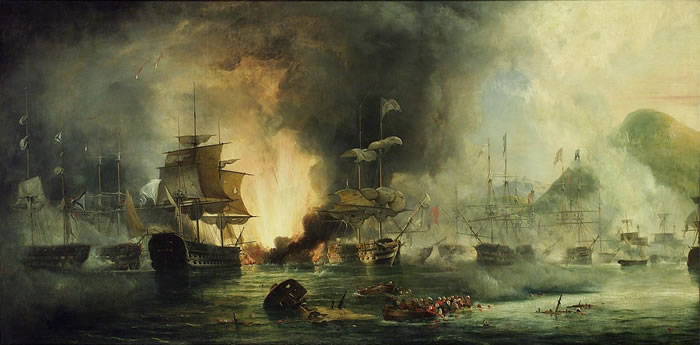
The Second Battle of Navarino (the first in 425 BC, then and now called Pylos, when the Athenians defeated the Spartans) was not only the last battle of sailing ships and the most one-sided battle in naval history but it was perhaps the most important battle in the history of Modern Greece and had it not been won by the combined British, French and Russian fleets against the Egyptian and Turkish fleets there might not have been a Greece.
In 1825 the War for Independence from the Turks had been going on for four years when the Sultan asked his vassal Mohammad Ali, who ruled Egypt, to end the rebellion once and for all. Ali sent his adopted son Ibraham Pasha, an Albanian, who began a program of exterminating or removing the Greeks of the Peloponessos to replace them with Muslims from Africa. This was unacceptable to British Foreign Minister George Canning who sent a fleet under Admiral Codrington to stop the genocide. On July 6 1827 the Treaty of London was signed and France and Russia also sent their ships to convince the Turks that a reconciliation was in their best interest. The Greek government in Nafplio accepted an armistice but the Turkish government refused.
On September 12th the Egyptian fleet was anchored in the large bay of Navarino along with a Turkish and Tunisian squadron and was warned by Codrington to cease hostilities towards the Greeks. Ibraham did indeed stop his naval activities but continued to burn villages and kill the Greeks on land. The admirals of the allied fleets sent a letter to Ibraham but it was returned by his officers who said they did not know where he was. The British decided on September 20th to enter the bay with their fleet and were joined by the French and the Russians. So now Navarino bay had several hundred warships staring at each other at point-blank range. The Egyptian commander sent Codrington an order to withdraw to which the British Admiral replied that he had not come to receive orders but to give them. He anchored his ship alongside the Warrior, the Egyptian flagship. Clearly the whole endeavor was meant as a bluff and the British expected the Egyptian-Turkish fleet to either pull up anchor and leave or sit down and sign some kind of non-aggression treaty. But when the Turks shot Lieutenant GWH Fitzroy and some of his crew as they sailed towards them in a small boat to give a message, the frigate Dartmouth opened fire as did every British, French and Russian ship. By evening sixty of the seventy-two enemy ships were sunk and over 6000 Egyptians and Turks were dead. The British, French and Russian's combined losses were 177 dead, 515 wounded and only a few ships damaged.
The destruction of the fleet left the Turks unable to control the Peloponessos and they were forced to leave, effectively opening the door for the creation of the modern Greek state. Of course the British Government was not too pleased with Admiral Codrington's destruction of the fleet and upsetting the balance of power in the Mediterranean since he was just sent to the Peloponessos to 'put pressure' on the Turks. Regardless, fate was on the side of Greece that day and were it not for this 'accident' people in the Peloponessos might very well be speaking Tunisian and going to mosques.
You can still see the wrecks of the sunken ships on a clear and calm day.
The painting was by George Phillip Reinagle, done in 1828 and is an eyewitness account of the battle.